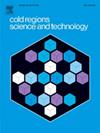Assessment of radar freeboard, radar penetration rate, and snow depth for potential improvements in Arctic sea ice thickness retrieved from CryoSat-2
IF 3.8
2区 工程技术
Q1 ENGINEERING, CIVIL
引用次数: 0
Abstract
The accuracy of Arctic sea ice thickness retrieved from the CryoSat-2 satellite is significantly influenced by the sea ice surface roughness, snow backscatter, and snow depth. In this study, four updated cases incorporating physical model-based radar freeboard, newly estimated radar penetration rate, and well-validated satellite snow depth were constructed to evaluate their potential improvements to the Alfred Wegener Institute's CryoSat-2 sea ice thickness (AWI CS2). The updated cases were then compared with airborne remotely sensed observations from the National Aeronautics and Space Administration's Operation IceBridge (OIB) and CryoSat Validation Experiment (CryoVEx) in 2013 and 2014, as well as with ground-based observations during the Multidisciplinary drifting Observatory for the Study of Arctic Climate (MOSAiC) expedition from October 2019 to April 2020. The results showed that all updated cases had the potential to improve the accuracy of sea ice thickness, maintaining comparable correlation coefficients and significantly reducing statistical errors compared to the AWI CS2. In the evaluation with OIB, CryoVEx, and MOSAiC, the four updated cases reduced the root mean square error of AWI CS2 by up to 0.68 m (55 %) against OIB, 0.76 m (53 %) against CryoVEx, and 0.47 m (76 %) against MOSAiC. The updated sea ice thicknesses retained the main distribution patterns generated by AWI CS2, but generally showed thinner sea ice thicknesses. From 2013 to 2018, the interannual variation trends between the updated cases and AWI CS2 varied regionally, but both show significant decreasing trends along the northern coasts of the Canadian Arctic Archipelago and Greenland. The updated schemes provided new insights into the retrieval of sea ice thickness using CryoSat-2, thereby further contributing to the quantification of the sea ice volume in the context of a warming climate.
从CryoSat-2获取的北极海冰厚度潜在改善的雷达干舷、雷达穿透率和雪深评估
由CryoSat-2卫星反演的北极海冰厚度精度受到海冰表面粗糙度、积雪后向散射和积雪深度的显著影响。在这项研究中,构建了四个更新的案例,包括基于物理模型的雷达干舷、新估计的雷达穿透率和经过验证的卫星雪深,以评估它们对阿尔弗雷德·韦格纳研究所CryoSat-2海冰厚度(AWI CS2)的潜在改进。然后将更新后的案例与2013年和2014年美国国家航空航天局冰桥行动(OIB)和CryoSat验证实验(CryoVEx)的机载遥感观测数据,以及2019年10月至2020年4月北极气候研究多学科漂流观测站(MOSAiC)考察期间的地面观测数据进行比较。结果表明,所有更新的案例都有可能提高海冰厚度的准确性,保持可比的相关系数,并显著减少与AWI CS2相比的统计误差。在OIB、CryoVEx和MOSAiC的评估中,4例更新病例与OIB相比,AWI CS2的均方根误差减少了0.68 m(55%),与CryoVEx相比减少了0.76 m(53%),与MOSAiC相比减少了0.47 m(76%)。更新后的海冰厚度保持了AWI CS2生成的主要分布格局,但海冰厚度普遍变薄。2013 - 2018年,更新病例数与AWI CS2的年际变化趋势存在区域差异,但在加拿大北极群岛北部海岸和格陵兰岛均呈现显著下降趋势。更新后的方案为利用CryoSat-2检索海冰厚度提供了新的见解,从而进一步促进了气候变暖背景下海冰体积的量化。
本文章由计算机程序翻译,如有差异,请以英文原文为准。
求助全文
约1分钟内获得全文
求助全文
来源期刊

Cold Regions Science and Technology
工程技术-地球科学综合
CiteScore
7.40
自引率
12.20%
发文量
209
审稿时长
4.9 months
期刊介绍:
Cold Regions Science and Technology is an international journal dealing with the science and technical problems of cold environments in both the polar regions and more temperate locations. It includes fundamental aspects of cryospheric sciences which have applications for cold regions problems as well as engineering topics which relate to the cryosphere.
Emphasis is given to applied science with broad coverage of the physical and mechanical aspects of ice (including glaciers and sea ice), snow and snow avalanches, ice-water systems, ice-bonded soils and permafrost.
Relevant aspects of Earth science, materials science, offshore and river ice engineering are also of primary interest. These include icing of ships and structures as well as trafficability in cold environments. Technological advances for cold regions in research, development, and engineering practice are relevant to the journal. Theoretical papers must include a detailed discussion of the potential application of the theory to address cold regions problems. The journal serves a wide range of specialists, providing a medium for interdisciplinary communication and a convenient source of reference.
 求助内容:
求助内容: 应助结果提醒方式:
应助结果提醒方式:


